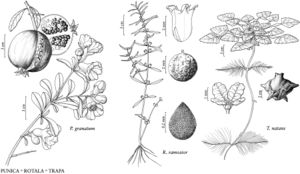Trapa
Sp. Pl. 1: 120. 1753.
| Taxon | Illustrator ⠉ | |
|---|---|---|
 | Punica granatum Rotala ramosior Trapa natans |
Herbs, annual, aquatic, rosette-forming, rooted or floating, to 50 dm (when rooted in deep water), glabrous or velutinous. Stems submerged, flexible, unbranched, submerged nodes often developing green, pinnately-dissected to filiform adventitious leaflike roots. Leaves dimorphic, flanked by deeply cleft stipules; floating leaves alternately or spirally arranged in terminal rosette, supported by slender to bulbous float at mid petiole, blade rhombic to triangular, base cuneate, margins coarsely toothed in distal 1/2; submerged leaves subopposite, sessile, blade linear, margins entire. Inflorescences indeterminate, emergent, solitary flowers in axils of floating leaves, pedicels elongating and declining after pollination, submerging developing fruit. Flowers pedicellate, actinomorphic, monostylous; floral-tube perigynous to semi-epigynous, campanulate; epicalyx segments absent; sepals 4, 3 times floral-tube length, persistent on fruit as hardened spines; petals caducous, 4, white or pale lavender; nectary development unknown; stamens 4, in 1 whorl; ovary 2-locular, surrounded by coronary disc, semi-inferior, fully inferior in fruit; placenta axile, abbreviated, at apex of ovary; style slender; stigma capitate; ovules 1 per locule, pendulous, 1 locule and ovule failing to develop after anthesis. Fruits drupes, top-shaped, woody, with 2–4 hardened, spiny horns, endocarp indurate, exocarp evanescent, with tubercles. Seed 1, oblong; cotyledons 2, unequal, 1 large, starchy, retained in fruit, the other scalelike, growing out of fruit apex, becoming photosynthetic.
Distribution
Introduced; Europe, Asia, Africa, widely in subtropical and temperate regions
Discussion
Species 1–30+ (1 in the flora).
Trapa is cultivated in China for the edible nut or enlarged cotyledon, which is referred to as water chestnut. The familiar cultivated Chinese water chestnut marketed in North America is usually another plant, the sedge Eleocharis dulcis (Burman f.) Trinius ex Henschel. Specialized features of Trapa (inflated leaf petioles, semi-inferior or fully inferior ovary, hardened horned fruits, unequal cotyledons) long made exact taxonomic placement difficult. Until recently, the genus was generally treated as the sole member of Trapaceae, with close relationship to Lythraceae or Onagraceae. Substantial molecular evidence indicates that Trapa is sister genus to Sonneratia Linnaeus f., a genus of mangrove trees in southeastern Asia. The two genera are well-nested within Lythraceae and closely related to two other Asian Lythraceae, Duabanga Buchanan-Hamilton, a genus of southeastern Asian trees, and Lagerstroemia, the crape myrtle (S. A. Graham et al. 2005). The great discrepancy in number of species attributed to the genus is primarily the result of extensive variability in the fruit shape and in the shape and number of horns and spines on the fruit. Trapa has become a notorious invader of rivers and lakes in the northeastern United States since its introduction in the nineteenth century. It was reported in southeastern Canada for the first time in 1998, extending the range northward from localities in the Lake Champlain watershed in the United States. Trapa fruits are well known from the Miocene, and younger, fossil deposits in the United States, Europe, and Asia.
Selected References
None.
Lower Taxa
"elongating" is not a number."timesfloral-tubelength" is not declared as a valid unit of measurement for this property.